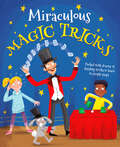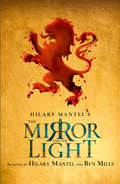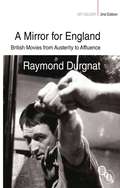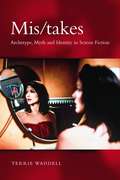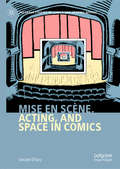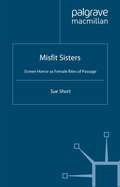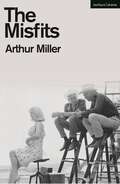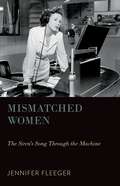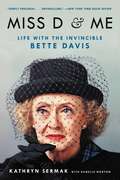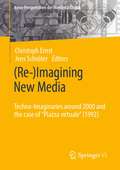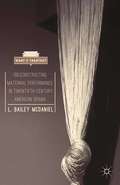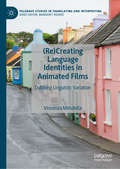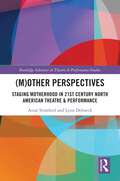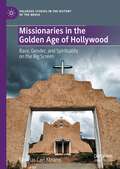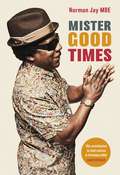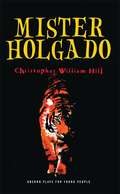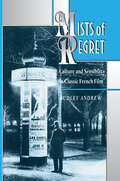- Table View
- List View
Miraculous Magic Tricks: Packed with dozens of dazzling tricks to learn in simple steps
by Mike LaneRoll up, roll up! Try your hand at these incredible and confounding magic tricks - from card, paper and card tricks to a little bit of mental magic... This how-to guide will teach children aged 7+ this miraculous art. Not only will they be able to entertain their friends and family, but learning these tricks will also help them develop their verbal skills, mental agility and physical dexterity. Full of warm and witty illustrations by David Mostyn, this full-colour book will provide endless fun.
Mirror: The Film Companion (KINOfiles Film Companion)
by Natasha SynessiosAt the centre of Tarkovsky's oeuvre, _Mirror_ is his most complex and autobiographical film. It stretches the viewer by moving without apparent effort between past, present and imagined realities, in a series of episodes which observe neither plot nor overt logic. The film reconstructs and records iconic memories and deep emotional impressions in the life of an individual, a nation and an era. Audience reaction to 'Mirror' was overwhelming and it came to represent a watershed in many people's lives. It also occasioned Tartovsky's first open dialogue with his viewers, as letters poured in to convince him of the importance and need for his films. It remains to this day most Russians' favourite Tarkovsky film.
The Mirror and the Light: Rsc Stage Adaptation
by Hilary Mantel Ben MilesHilary Mantel and Ben Miles’ exhilerating stage adaptation of The Mirror and the Light, one of 2021’s must-see theatrical events, and the long awaited conclusion to the Oliver Award-winning Wolf Hall Trilogy.
A Mirror for England: British Movies from Austerity to Affluence (BFI Silver)
by Raymond DurgnatRaymond Durgnat's classic study of British films from the 1940s to the 1960s, first published in 1970, remains one of the most important books ever written on British cinema. In his introduction, Kevin Gough-Yates writes: 'Even now, it astounds by its courage and its audacity; if you think you have an 'original' approach to a filmor a director's work and check it against A Mirror for England, you generally discover that Raymond Durgnat had said it already.' Durgnat himself said about the book that 'the main point was arranging a kind of rendezvous between thinking about movies and thinking, not so much about sociology, as about the experiences that people are having all the time.'Durgnat used Mirror to assert the validity of British cinema against its dismissal by the critics of Cahiers du cinéma and Sight and Sound. His analysis takes in classics such as In Which We Serve (1942), A Matter of Life and Death (1946) and The Blue Lamp (1949), alongside 'B' films and popular genres such as Hammer horror. Durgnat makes a cogent and compelling case for the success of British films in reflecting British predicaments, moods and myths, at the same time as providing some disturbing new insights into a national character by whose enigmas and contradictions we continue to be perplexed and fascinated.
Mis/takes: Archetype, Myth and Identity in Screen Fiction
by Terrie WaddellMis/takes departs from the bulk of screen discourse by applying Jungian and Post-Jungian ideas on unconscious processes to popular film and television. This perspective offers a rich insight into the way that various myths infiltrate popular culture. By examining the function of psychological motifs and symbols in cinema and television, Terrie Waddell opens up another way of thinking about how identity can be constructed and disrupted. Mulholland Drive, Memento, The Others, The X-Files, Twin Peaks, The Sopranos, Spider, Intimacy and Absolutely Fabulous all lend themselves to this approach. The close analysis of these films/programs are guided by a number of core archetypes from trickster and Self to incest and the grotesque. The book’s four parts reflect these dominant patterns: Jung, trickster and the screen Mistaken identities, self-deception and the undead Redeemers, bad dads and matricide Excesses of the sad and the sassy Mis/takes gives readers a chance to engage with screen material in an original and subversive way. This study will be of great interest to Jungian analysts and students of film, cultural studies, media, gender studies and analytical psychology.
Mis/takes: Archetype, Myth and Identity in Screen Fiction
by Terrie WaddellMis/takes departs from the bulk of screen discourse by applying Jungian and Post-Jungian ideas on unconscious processes to popular film and television. This perspective offers a rich insight into the way that various myths infiltrate popular culture. By examining the function of psychological motifs and symbols in cinema and television, Terrie Waddell opens up another way of thinking about how identity can be constructed and disrupted. Mulholland Drive, Memento, The Others, The X-Files, Twin Peaks, The Sopranos, Spider, Intimacy and Absolutely Fabulous all lend themselves to this approach. The close analysis of these films/programs are guided by a number of core archetypes from trickster and Self to incest and the grotesque. The book’s four parts reflect these dominant patterns: Jung, trickster and the screen Mistaken identities, self-deception and the undead Redeemers, bad dads and matricide Excesses of the sad and the sassy Mis/takes gives readers a chance to engage with screen material in an original and subversive way. This study will be of great interest to Jungian analysts and students of film, cultural studies, media, gender studies and analytical psychology.
The Misadventures of Tallulah Casey 3-Book Collection: Withering Tights; A Midsummer Tights Dream; A Taming Of The Tights
by Louise RennisonThree hilarious Tallulah Casey novels by the original Queen of Teen and bestselling author of Angus, Thongs and Full-frontal Snogging!
Mise en scène, Acting, and Space in Comics (Palgrave Studies in Comics and Graphic Novels)
by Geraint D'ArcyThis book explores some of the less frequently questioned ideas which underpin comics creation and criticism. “Mise en scène” is a term which refers to the way in which visual elements work together to create meaning in comics. It is a term that comics have borrowed from cinema, which borrowed it in turn from theatre. But comics are not film and they are not cinema, so how can this term be of any use? If we consider comics to have mise en scène, should not we also ask if the characters in comics act like the characters on film and stage? In its exploration of these ideas, this book also asks what film and theatre can learn from comics.
Mise en Scène and Film Style: From Classical Hollywood to New Media Art (Palgrave Close Readings in Film and Television)
by A. MartinStyles of filmmaking have changed greatly from classical Hollywood through to our digital era. So, too, have the ways in which film critics and scholars have analysed these transformations in film style. This book explores two central style concepts, mise en scène and dispositif, to illuminate a wide range of film and new media examples.
Misfit Sisters: Screen Horror as Female Rites of Passage
by S. ShortThis timely study breaks new ground in exploring how recent film and television horror texts articulate a female rite of passage, updating the cautionary concerns found in fairy tales of the past, particularly in warning against predatory men, treacherous females and unhappy family situations.
The Misfits: The Misfits; After The Fall; Incident At Vichy; The Price; Creation Of The World; Playing For Time
by Arthur MillerDiscover the cinema-novelization of Arthur Miller's 1961 American western film, The Misfits, which was directed by John Huston and went on to be one of the most popular cult films of the 1960s.A story of four lost souls - the beautiful Roslyn who has never belonged to anyone or anything, and three other misfits who roam the open land existing on the little money made from riding in rodeos and rounding up wild horses - who meet in Reno to discover that freedom has its price, and the heart its rules.The Misfits starred Clark Gable, Marilyn Monroe and Montgomery Cliff. Based on a short story of the same name, originally published in 1957, this cinema novel of the film includes an introduction by Arthur Miller himself.
The Misfits
by Arthur MillerDiscover the cinema-novelization of Arthur Miller's 1961 American western film, The Misfits, which was directed by John Huston and went on to be one of the most popular cult films of the 1960s.A story of four lost souls - the beautiful Roslyn who has never belonged to anyone or anything, and three other misfits who roam the open land existing on the little money made from riding in rodeos and rounding up wild horses - who meet in Reno to discover that freedom has its price, and the heart its rules.The Misfits starred Clark Gable, Marilyn Monroe and Montgomery Cliff. Based on a short story of the same name, originally published in 1957, this cinema novel of the film includes an introduction by Arthur Miller himself.
Mismatched Women: The Siren's Song Through the Machine (Oxford Music / Media)
by Jennifer FleegerIn Mismatched Women, author Jennifer Fleeger introduces readers to a lineage of women whose voices do not "match" their bodies by conventional expectations, from George du Maurier's literary Trilby to Metropolitan Opera singer Marion Talley, from Snow White and Sleeping Beauty to Kate Smith and Deanna Durbin. The book tells a new story about female representation by theorizing a figure regularly dismissed as an aberration. The mismatched woman is a stumbling block for both sound and feminist theory, argues Fleeger, because she has been synchronized yet seems to have been put together incorrectly, as if her body could not possibly house the voice that the camera insists belongs to her. Fleeger broadens the traditionally cinematic context of feminist film theory to account for literary, animated, televisual, and virtual influences. This approach bridges gaps between disciplinary frameworks, showing that studies of literature, film, media, opera, and popular music pose common questions about authenticity, vocal and visual realism, circulation, and reproduction. The book analyzes the importance of the mismatched female voice in historical debates over the emergence of new media and unravels the complexity of female representation in moments of technological change.
Miss D and Me: Life with the Invincible Bette Davis
by Kathryn SermakFor ten years Kathryn Sermak was at Bette Davis's side--first as an employee, and then as her closest friend--and in Miss D and Me she tells the story of the great star's harrowing but inspiring final years, a story fans have been waiting decades to hear. Miss D and Me is a story of two powerful women, one at the end of her life and the other at the beginning. As Bette Davis aged she was looking for an assistant, but she found something more than that in Kathryn: a loyal and loving buddy, a co-conspirator in her jokes and schemes, and a competent assistant whom she trained never to miss a detail. But Miss D had strict rules for Kathryn about everything from how to eat a salad to how to wear her hair...even the spelling of Kathryn's name was changed (adding the "y") per Miss D's request. Throughout their time together, the two grew incredibly close, and Kathryn had a front-row seat to the larger-than-life Davis's career renaissance in her later years, as well as to the humiliating public betrayal that nearly killed Miss D. The frame of this story is a four-day road trip Kathryn and Davis took from Biarritz to Paris, during which they disentangled their ferocious dependency. Miss D and Me is a window into the world of the unique and formidable Bette Davis, told by the person who perhaps knew her best of all.
Miss D and Me: Life with the Invincible Bette Davis
by Kathryn SermakFor ten years Kathryn Sermak was at Bette Davis's side--first as an employee, and then as her closest friend--and in Miss D and Me she tells the story of the great star's harrowing but inspiring final years, a story fans have been waiting decades to hear.Miss D and Me is a story of two powerful women, one at the end of her life and the other at the beginning. As Bette Davis aged she was looking for an assistant, but she found something more than that in Kathryn: a loyal and loving buddy, a co-conspirator in her jokes and schemes, and a competent assistant whom she trained never to miss a detail. But Miss D had strict rules for Kathryn about everything from how to eat a salad to how to wear her hair...even the spelling of Kathryn's name was changed (adding the "y") per Miss D's request. Throughout their time together, the two grew incredibly close, and Kathryn had a front-row seat to the larger-than-life Davis's career renaissance in her later years, as well as to the humiliating public betrayal that nearly killed Miss D. The frame of this story is a four-day road trip Kathryn and Davis took from Biarritz to Paris, during which they disentangled their ferocious dependency. Miss D and Me is a window into the world of the unique and formidable Bette Davis, told by the person who perhaps knew her best of all.
**Missing**: Techno-Imaginaries around 2000 and the case of "Piazza virtuale" (1992) (Neue Perspektiven der Medienästhetik)
by Christoph Ernst Jens SchröterThe late 20th century was a formative phase in the history of digital media culture. The introduction of "new media" was associated with promises for the future that still resonate today. This book brings together contributions that discuss key aspects of the "imaginaries" surrounding new media in this epoch. The focus is on the works of the media artist group Van Gogh-TV, especially the historically very important interactive television project "Piazza virtuale" (1992).
**Missing** (What is Theatre?)
by L. Bailey McDanielLooking at a century of American theatre, McDaniel investigates how race-based notions of maternal performance become sites of resistance to cultural and political hierarchies. This book considers how the construction of mothering as universally women's work obscures additional, equally constructed subdivisions based in race and class.
**Missing**: Dubbing Linguistic Variation (Palgrave Studies in Translating and Interpreting)
by Vincenza MinutellaThis book describes the dubbing process of English-language animated films produced by US companies in the 21st century, exploring how linguistic variation and multilingualism are used to create characters and identities and examining how Italian dubbing professionals deal with this linguistic characterisation. The analysis carried out relies on a diverse range of research tools: text analysis, corpus study and personal communications with dubbing practitioners. The book describes the dubbing workflow and dubbing strategies in Italy and seeks to identify recurrent patterns and therefore norms, as well as stereotypes or creativity in the way multilingualism and linguistic variation are tackled. It will be of interest to students and scholars of translation, linguistic variation, film and media.
**Missing**: Staging Motherhood in 21st Century North American Theatre & Performance (Routledge Advances in Theatre & Performance Studies)
by Aoise StratfordThis anthology examines maternity in contemporary performance at the intersection of a wide range of topics from nationhood to mental health, queer parenting, embodied dramaturgy, cultural practice, and immigration. Across the breadth of these themes, we interrogate the cultural implications and politics of how we script, perform, receive, and define mothers, challenging many of the normalizing and patriarchal tropes associated with the mother-as-character. This book includes critical essays examining twenty-first century dramatic literature, first-hand ethnographic accounts of motherhood in practice, interviews, feminist manifestos, and artist reflections. In its deliberately curated variety, this collection seeks to resist homogeneity and offer instead a range of approaches to key questions: what versions of motherhood get staged, and why? And how do dramatic representations tell us about the role of mothers in our own fraught contemporary moment? This collection will be of great interest to those in academia who are teaching, researching, or studying in the fields of Theatre and Performance Studies, American Studies, and Feminist and Gender Studies.
**Missing**: Staging Motherhood in 21st Century North American Theatre & Performance (Routledge Advances in Theatre & Performance Studies)
This anthology examines maternity in contemporary performance at the intersection of a wide range of topics from nationhood to mental health, queer parenting, embodied dramaturgy, cultural practice, and immigration. Across the breadth of these themes, we interrogate the cultural implications and politics of how we script, perform, receive, and define mothers, challenging many of the normalizing and patriarchal tropes associated with the mother-as-character. This book includes critical essays examining twenty-first century dramatic literature, first-hand ethnographic accounts of motherhood in practice, interviews, feminist manifestos, and artist reflections. In its deliberately curated variety, this collection seeks to resist homogeneity and offer instead a range of approaches to key questions: what versions of motherhood get staged, and why? And how do dramatic representations tell us about the role of mothers in our own fraught contemporary moment? This collection will be of great interest to those in academia who are teaching, researching, or studying in the fields of Theatre and Performance Studies, American Studies, and Feminist and Gender Studies.
Missionaries in the Golden Age of Hollywood: Race, Gender, and Spirituality on the Big Screen (Palgrave Studies in the History of the Media)
by Douglas Carl AbramsThis book examines major British and American missionary films during the Golden Age of Hollywood to explore the significance of race, gender, and spirituality in relation to the lives of the missionaries portrayed in film during the middle third of the twentieth century. Film both influences and reflects culture, and racial, gender, and religious identities are some of the most debated issues globally today. In the movies explored in this book, missionary interactions with various people groups reflect the historical changes which took place during this time.
Mister Good Times
by Norman JayTHE ENTHRALLING LIFE STORY OF THE LEGENDARY DJ, NORMAN JAY MBE 'Norman Jay's contribution to club culture is immeasurable . . . He brought new life to undiscovered classics and in doing so turned on a whole new generation' David RodiganMister Good Times is the enthralling story of a black kid growing up in a (largely white) working class world; of vivid, often violent experiences on the football terraces; of the emerging club scene growing out of a melting pot of styles; of how Jay, with his contemporaries, took the music of Black America, gave it a distinctly London twist, and used the marriage of styles to forge a hugely successful career as a trailblazing DJ and broadcaster, becoming an inspiration to a whole generation of dance music fans, black and white, without ever compromising his integrity.Along the way are tales of adventures across the country following Spurs; of Northern Soul nights, warehouse parties and illegal raves; of sound systems, the good and bad times of the Notting Hill carnival, the heady days of pirate radio, Rare Groove and the burgeoning British dance music scene.Mister Good Times is the story of a man who has lived his life on his own terms, helping to define a new British culture.
Mister Holgado (Oberon Plays for Young People)
by Christopher William HillWhen little Conrad Van der Bosch claims he has an invisible tiger called Sigmund hiding on his wardrobe, his child-psychologist father sees the ‘lie’ as a deliberate act of juvenile defiance. Doctor Van der Bosch is concerned that the boy is mentally maladjusted and in an attempt to terrify Conrad into admitting that there never was an invisible tiger, creates the terrifying figure of Mister Holgado, a child-eating monster who is apparently hiding inside Conrad’s wardrobe, waiting to consume the little boy. This triggers a battle for supremacy, as Conrad and his father struggle to manipulate the myth of Holgado. In desperation, as the Doctor fails to curtail his son’s imagination, he realises he has no choice but to become the child-eating Holgado.
Mists of Regret: Culture and Sensibility in Classic French Film
by Dudley AndrewJust before World War II, French cinema reached a high point that has been dubbed the style of "poetic realism." Working with unforgettable actors like Jean Gabin and Arletty, directors such as Renoir, Carné, Gremillon, Duvivier, and Chenal routinely captured the prizes for best film at every festival and in every country, and their accomplishments led to general agreement that the French were the first to give maturity to the sound cinema. Here the distinguished film scholar Dudley Andrew examines the motivations and consequences of these remarkable films by looking at the cultural web in which they were made. Beyond giving a rich view of the life and worth of cinema in France, Andrew contributes substantially to our knowledge of how films are dealt with in history. Where earlier studies have treated the masterpieces of this era either in themselves or as part of the vision of their creators, and where certain recent scholars have reacted to this by dissolving the masterpieces back into the system of entertainment that made them possible, Andrew stresses the dialogue of culture and cinema. In his view, the films open questions that take us into the culture, while our understanding of the culture gives energy, direction, and consequence to our reading of the films. The book demonstrates the value of this hermeneutic approach for one set of texts and one period, but it should very much interest film theorists and film historians of all sorts.
Mists of Regret: Culture and Sensibility in Classic French Film
by Dudley AndrewJust before World War II, French cinema reached a high point that has been dubbed the style of "poetic realism." Working with unforgettable actors like Jean Gabin and Arletty, directors such as Renoir, Carné, Gremillon, Duvivier, and Chenal routinely captured the prizes for best film at every festival and in every country, and their accomplishments led to general agreement that the French were the first to give maturity to the sound cinema. Here the distinguished film scholar Dudley Andrew examines the motivations and consequences of these remarkable films by looking at the cultural web in which they were made. Beyond giving a rich view of the life and worth of cinema in France, Andrew contributes substantially to our knowledge of how films are dealt with in history. Where earlier studies have treated the masterpieces of this era either in themselves or as part of the vision of their creators, and where certain recent scholars have reacted to this by dissolving the masterpieces back into the system of entertainment that made them possible, Andrew stresses the dialogue of culture and cinema. In his view, the films open questions that take us into the culture, while our understanding of the culture gives energy, direction, and consequence to our reading of the films. The book demonstrates the value of this hermeneutic approach for one set of texts and one period, but it should very much interest film theorists and film historians of all sorts.
